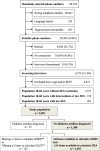Low health literacy is associated with higher risk of type 2 diabetes: a cross-sectional study in Germany
- PMID: 33726714
- PMCID: PMC7962353
- DOI: 10.1186/s12889-021-10508-2
Low health literacy is associated with higher risk of type 2 diabetes: a cross-sectional study in Germany
Abstract
Background: Low health literacy is believed to be associated with behaviours that increase the risk of type 2 diabetes. But there is limited knowledge on the relation between health literacy (HL) and diabetes risk, and whether improving HL could be a potential prevention strategy. Therefore, the main purpose of this study was to examine the link between HL and diabetes risk among non-diabetic adults.
Methods: We used data from the Hamburg Diabetes Prevention Survey, a population-based cross-sectional study in Germany. One thousand, two hundred and fifty-five non-diabetic subjects aged 18-60 years were eligible. The German Diabetes Risk Score (GDRS, ranging 0 to 123 points) was used to determine the individual risk of type 2 diabetes. The short version of the European Health Literacy Questionnaire (HLS-EU-Q16, ranging 0 to 16 points) was applied to assess the individual self-reported HL. Subjects were asked to self-estimate their diabetes risk, which was then compared with the calculated GDRS. Descriptive statistics were calculated to investigate group differences in the GDRS and self-estimated diabetes risk. Linear as well as logistic regression models were performed to analyse potential influencing variables of the GDRS as well as incorrect self-estimated diabetes risk. In three nested statistical models for each outcome, these analyses were adjusted for age, gender, educational level and the presence of chronic conditions.
Results: According to the criteria of the GDRS, 996 (79.4%) subjects showed "low risk", 176 (14.0%) "still low risk", 53 (4.2%) "elevated risk", and 30 (2.4%) "high to very high risk" to develop type 2 diabetes within the next 5 years. In the statistical models including all control variables, subjects with "inadequate HL" scored 2.38 points higher on the GDRS (95% CI 0.378 to 4.336; P = 0.020) and had a 2.04 greater chance to estimate their diabetes risk incorrectly (OR 2.04; 95% CI 1.33 to 3.14; P = 0.001) compared to those with "sufficient HL".
Conclusion: The risk of type 2 diabetes is increased in people with inadequate self-reported HL. People with high diabetes risk and inadequate HL might be provided with educational programs to improve diabetes knowledge and reduce behavioural risk factors.
Keywords: Diabetes risk; GDRS; HLS-EU-Q16; Health literacy; Prevention; Type 2 diabetes.
Conflict of interest statement
The authors declare that they have no competing interests.
Figures



References
-
- IDF. IDF DIABETES ATLAS Eighth edition. http://diabetesatlas.org/resources/2017-atlas.html. Accessed 25 Aug 2019.
-
- Kickbusch I, Pelikan JM, Apfel F, Tsouros AD. The solid facts: health literacy. Denmark: The World Health Organisation Regional Office for Europe; 2013.
Publication types
MeSH terms
LinkOut - more resources
Full Text Sources
Other Literature Sources
Medical

